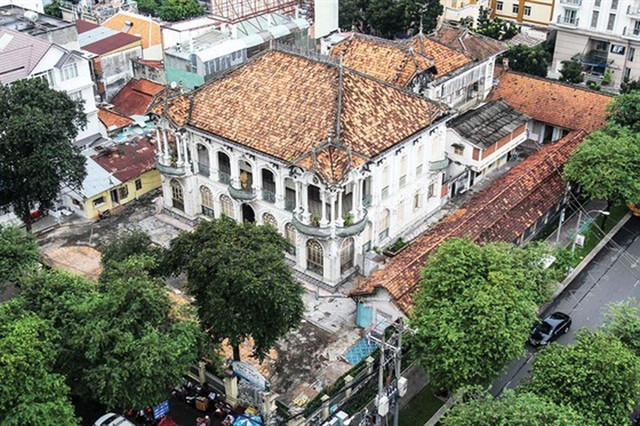 The old Phuong Nam villa, one of the city’s most well-known buildings of its type, is on the list of ancient villas that need preservation. (Photo: sggp.org.vn)
The old Phuong Nam villa, one of the city’s most well-known buildings of its type, is on the list of ancient villas that need preservation. (Photo: sggp.org.vn)The list now has more than 200 villas.
The buildings, which have historical, cultural and architecturalvalues, include one at 12 Ly Tu Trong and 6B Ngo Thoi Nhiemstreets and a 100-year-old villa at 237 No Trang Long street in Binh Thanh district.
Sustainablevilla conservation in the long run should take into account economic gains forvilla owners, the city said.
Asurvey by the HCM City Department of Planning and Architecture in August2020 showed 560 out of the 1,550 pre-1975 villas in the city are no longer intheir original form.
The villas are classified into three groups based on their historical andcultural importance, with detailed regulations for preservation. Buildingsin groups 1 and 2 must be preserved, while buildings in group 3 have littlehistoric or architectural value and can be demolished.
In the first group, exterior architectural form, internal structure,construction density, number of floors and height have to be maintained.The external architectural shape must be maintained for villas in thesecond group.
The owner of villas in group 3 must comply with the laws on building andarchitectural planning management.
The committee has asked the owners to comply with regulations on renovation andconservation of old villas, the Housing Law, and regulations on the managementand use of State-owned villas.
Repairs and renovation must comply with the Law on Cultural Heritage to ensurethe protection of cultural, art or historical value of the villas.
Hoang Minh Tri, former director of the city's Institute for Urban Planning,said it was important to have regular maintenance on old culturalbuildings and government involvement in establishing preferential policiesfor villa owners to ensure they are engaged in preserving local culture.
Archeologist Dr. Nguyen Thi Hau proposed that regulationshonouring villa owners’ wishes and financial benefits be added to thecurrent Law on Cultural Heritage.
The city established the Council for Villa Classification in 2015,approved the general criteria for classification in 2018, and first issued thedecision to start classifying villas in 2020.
Before the regulations were issued, authorities could not interfere with thevilla owners’ decisions and many were demolished or have fallen into disrepairin recent years. Some old villas have been renovated to become schools,restaurants or coffee shops.
The city has about 3,000 valuable old houses and villas that could be preservedproperly but are likely to be demolished, according to the ArchitectureResearch Centre under the city’s Department of Planning and Architecture.
Of that number, nearly 1,300 houses were built before 1975. About 168 of themare under State management and receive funds from the city’s budget for repairand preservation. However, only a few houses remain in good condition./.




























